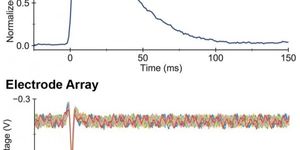HIV Vaccine Successful in Non-human Primates
Researchers have been trying to create a vaccine for HIV, the virus that causes AIDS, for decades. Scientists at Scripps Research have reported new work in the journal Immunity that has shown that an experimental vaccine strategy they developed has been successful in a non-human primate model - rhesus macaque monkeys. The monkeys produced antibodies against a strain of HIV that is similar to one commonly infecting people, which is called a Tier 2 virus. This is also the first work to demonstrate the level of antibodies that a vaccine needs to produce in order to protect a person against HIV infection.
"We found that neutralizing antibodies that have been induced by vaccination can protect animals against viruses that look a lot like real-world HIV," said Dennis Burton, Ph.D., chair of Scripps Research's Department of Immunology and Microbiology, and scientific director of the International AIDS Vaccine Initiative (IAVI) Neutralizing Antibody Center and of the National Institutes of Health's Center for HIV/AIDS Vaccine Immunology and Immunogen Discovery (CHAVI-ID).
It’s still a long way from clinical trials in people, but this work shows that the strategy developed by Burton and colleagues should be pursued. The scientists aim to find the vulnerable parts of the virus and teach the human immune system to generate antibodies that will attack those parts.
Previous work led by Scripps Research investigators pinpointed the outer envelope protein trimer of the virus as a vulnerability. Animal studies confirmed that antibodies were effective on the area. The trimer is unstable, however, and difficult to use in a vaccine. Eventually, researchers were able to create a more stable version of the trimer, called SOSIP, in 2013.
"For the first time, we had something that looked pretty much like the HIV envelope protein trimer," explained the co-first author of the new report, Matthias Pauthner, Ph.D., a research associate at Scripps Research.
The scientists designed a vaccine that contained the SOSIP trimer and went to work investigating whether animals were protected. Investigators had already learned that some monkeys had low antibody levels, or titers, after being exposed to the vaccine but in other monkeys, titers were high. In this work, they re-vaccinated six low- and six high-titer monkeys, and twelve that were unimmunized.
The re-vaccinated primates were exposed to SHIV, a simian version of HIV with an envelope trimer that matches the human one. Like circulating HIV strains that infect people, SHIV is a Tier 2 virus because it is tough to neutralize. In the high-titer animals that were re-vaccinated, however, the strategy prevented infection.
"Since HIV emerged, this is the first evidence we have of antibody-based protection from a Tier 2 virus following vaccination," said Pauthner. "One question now is how can we get such high titers into every animal?"
Titers are important to watch because protection from HIV waned as time went on, and titers fell. The researchers saw that titers had to be maintained to keep up the shield against HIV. Those neutralizing antibodies were critical to stopping the virus, unlike other parts of the immune system. Pauthner noted the significance of this finding; other labs often use immune T cells in their work instead.
The scientists want to keep titers high and improve the vaccine for human trials. "There are many immunological tricks that can be explored to make immunity last longer," said Pauthner.
Next, the investigators are going to attempt to use molecules called broadly neutralizing antibodies (bnAbs), which are effective against many different HIV strains instead of just one, like these studies. This work helps lay the foundation for those future work. "This research gives an estimate of the levels of bnAbs that we may need to induce through vaccination in order to protect against HIV globally," explained Burton.
Learn more about why it’s important to create a vaccine for HIV from the video above by Harvard University.
Sources: AAAS/Eurekalert! Via Scripps Research Institute, Immunity










